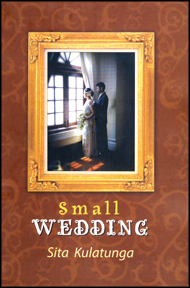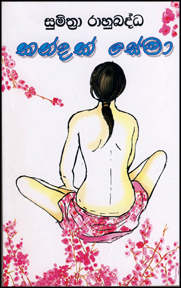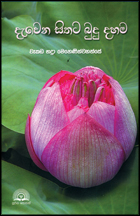|

A Small Wedding:
Microscopic depiction of change of milieu
Reviewed by Ranga CHANDRARATHNE
A Small Wedding, the novella by veteran writer Sita Kulatunga though
deals with a common place experience of a wedding, has, in fact,
captured inevitable socio-cultural changes that occurred in
post-independent Sri Lanka.
"Stepping on to the *poruwa* Avanti swept the audience with a quick
wide glance. She had come down the aisle with her father followed by her
close relations. The two grandmothers also walked with a heroic effort.
As the drums ceased the old man whom Agbo, Siddhartha and others dubbed
ritual uncle took over. The flowers at the entrance to the *poruwa*
reminded Avanti the blossoms near her rooms at Cambridge.
 She broke into a giggle almost forgetting that she was the bride when
she spotted her knife uncle. She wanted to point out knife to Siddhartha
but the ritual started and she wouldn't as the moment was too solemn.
Siddhartha who had been fascinated by uncle Atula's description of knife
would have liked to be introduced to knife. But in what language would
they communicate? Knife might shake hands or perhaps bring his palms
together and say namasthe. Anyway there will be a time to introduce him.
I have a feeling that he quite likes me. She broke into a giggle almost forgetting that she was the bride when
she spotted her knife uncle. She wanted to point out knife to Siddhartha
but the ritual started and she wouldn't as the moment was too solemn.
Siddhartha who had been fascinated by uncle Atula's description of knife
would have liked to be introduced to knife. But in what language would
they communicate? Knife might shake hands or perhaps bring his palms
together and say namasthe. Anyway there will be a time to introduce him.
I have a feeling that he quite likes me.
If he had any little ailment when we were on holiday, it was to me
that he came not to my father, mother or brother, she thought, a dubious
honour. Avanti was flattered that he sought her. Some of their poor
relations wouldn't turn up at their wedding thinking that it was too
highflying for them. This kind of fashionable cosmopolitan function was
not for them. They would feel out of place they thought. Knife had
suppressed all those qualms. What Avanti could not get over was Knife
bappa's three piece suit. What a lot of trouble he had taken and how
Uncomfortable he must be feeling.
From the very first sentence, it is clear that the "Small wedding"
would be a meeting place for diverse cultures and dramatic personnel
from equally diverse social strata. The bride Avanti is a Sri Lankan
though she is educated in the UK where she met Siddhartha. Throughout
the novella, the themes such as globalisation, diaspora and change of
milieu and loss of inheritance have been skilfully woven into tapestry
of narration that takes readers into the forgotten milieu. Avanti and
her brother Agbo represent the second generation of diasporic Sri Lankan
community.
They have little memory of Sri Lanka. They are strangers to their
motherland or perhaps, their parents' land. The author skilfully
compares the cosmopolitan members of the extended family with their
elder counterparts who still live in villages adhering to age-old norms
and traditions. The contrast is so wide that most of them cannot
communicate with the bride groom because of language barrier. For the
older generation, the full suite with a tie seems ill-fitting. Though
the venue of the wedding is posh five star hotels in the metropolitan
Colombo, most of the members are not upper middle class members.
"be quite capable of breaking into the hotel in his sarong and shirt
and asking Abaya whether blood relations were given short shrift because
suddas took the first place. There were a few whites their friends
combining a holiday with attending the wedding; and also few of the
couple's friends from Cambridge.
What an odd cosmopolitan crowd, Avanti thought. Although the venue of
the wedding was upper class, there weren't very many upper class guests.
Most of the guests were from the two villages of Kadigamuwa and
Berugoda and from the branches of the different families that had spread
to different parts of the country. Many of them were professionals, a
couple of politicians thrown in.
Anyhow the hall was full. Siddhartha whispered in her ear to ask what
about a coconut. As we get down from the *poruwa* a coconut would be
split in two. "Watch now", said the bride. Just then ritual uncle's
assistant pulled out a dirty gunny bag (to save the hotel floor) placed
the coconut on it and hit it hard with a manna knife. It was an
excellent job. Each half of the coconut retained its share of water. The
coconut was split exactly in two. The couple will have long life and a
blissful marriage. Siddhartha was bearing with aplomb the long drawn
marriage ceremony. But he realized that this was not as long as the
Hindu ceremony.
Though a north Indian he had not witnessed many Hindu marriages as he
was born and bred elsewhere. The two of them had met at Cambridge. Some
of Avanti's relatives commented that it was better than marrying a
white. Yet others didn't condone marrying a foreigner at all. The first
thing that disturbed Avanti's relations was neither racial religious nor
geographic but his name. *Ane ammo vas vadinne nadda? They exclaimed.
Siddhartha was Buddha's lay name. The Buddha was called Siddhartha
Gautama.
In this country no Buddhist Hindu or Christian named a child
Siddhartha." This is loss of inheritance. For instance, Siddhartha
though he is an Indian, is not familiar with Hindu customs associated
with marriage like his bride Avanti. Avanti's brother Agbo though
educated in the West, loves his motherland and tries to learn about its
customs and traditions.
Though obvious the device by which the author narrates the
socio-cultural life of the past is through biographical notes of an
aunt. The aunt's diary which occupies a sizable portion of the novella
codifies an important facet of cultural life in the post independent Sri
Lanka. The author has been logical in selecting the marriage which is
centre of norms and customs of the day.
Particularly those sections which describe in elaborate terms the
minutest details of wedding in the pre-independent Sri Lanka, at times,
are like anthropological notes. For instance, the grandma's (Achchi)
elder brother gave a lunch to his boss superintendent of the estate he
worked describes the kind of preparation that had been made to welcome
the European master.
The account of the diary in a subtle way marks the gradual change of
milieu, particularly reducing the custom-bound restrictions imposed on
women. In a slow moving narration, the author portrays the forgotten
cultural landscape drawing parallels with socio-cultural changes brought
about by globalisation. It is marked for its simplicity in diction and
insight into the past. The book is published by Sarasavi Publishers.
Tertiary Education in Sri Lanka
Reviewed by Dr. S.B. Ekanayake
Tertiary Education in Sri Lanka - Relevance in the Global Context
Author: Professor Wiswa Warnapala
Printer/Publisher: Lassana Printers & Publishers (Pvt) Ltd
Year - July 2009
This publication on "Tertiary Education in Sri Lanka-Relevance in the
Global Context" is a follow up of the author's previous publication
titled "Higher Education Policy in Sri Lanka: New Perspectives and
Change". Like the previous publication this too is based on a lecture
series, numbering twenty two, delivered by Prof. Wiswa Warnapala on
Higher Education in Sri Lanka. The focus of this publication relates to
three important issues that confront higher education in Sri Lanka,
namely (a) Technical Education (b) Higher Education Policy and (c)
Unrest in the Universities.
The focus on Technical Education is very appropriate and timely since
it has a direct bearing on the development aspects of the country, as
well as, assuring avenues for employment for the large numbers that come
out from universities and other higher educational institutes.
Competencies in technical skills have been part of the history of the
human kind and their development which is now pronounced more than ever
before. Today development of a nation is logically associated with the
inertias of technical know how.
Hence, the importance of this area in the context of modern
development in Sri Lanka.
In the first of his lecturers speaking on "Technical Education Needs
and a New Approach" he traces the modest approaches attempted by the
governments since 1956 to foster Technical Education (TE) at various
levels with little success. By and large, the universities had neglected
TE as a matter of policy although the Ten Year Plan in 1957, the first
of its kind in Sri Lanka, had been very specific on the importance of
technical and scientific education in the development of the nation. He
traces the history of TE from the 19th century which saw the
establishment of the Ceylon Technical College in 1883, on a very modest
footing, to the current well organised umbrella organizations, namely,
Sri Lanka Institute of Advanced Technical Education (SLIATE) and
Tertiary and Vocational Education Commission (TVEC). SLIATE provides
many needs of the industry in the country through provision of skills
and courses catering to the needs of the region and keeping abreast of
the new millennium development goals. All institutions dealing with
technical and vocational education have to register at this apex body,
TVEC However, there is much to be desired in the connections between the
industry and training programmes.
Professor Warnapala laments on the flaws and draws attention of those
responsible professionals to look into these lapses. Realising the
urgency Prof. Warnapala proposes the need for (a) modernization of TE
(b) provision of facilities and expansion of TE to rural areas (c)
collaboration with the needs of the industry (d) moving away TE from the
traditional elitist higher education policies and practices and (e)
encouraging private sector organizations to assist in developing TE, as
is seen in the current policies of many of the Asian countries.
Professor Warnapala very eloquently argues the need for change in the
directions of education in general and higher education specifically.
"Free Education" was the need of the hour in the 1940's and this has
resulted in an upsurge of more students receiving education over the
years. But he rightly questions the wisdom of this policy in the present
context and strongly advocates "education for development specifically,
development - oriented Higher Education Policy". This, he argues, would
certainly augment and underscore our system to be competitive
internationally. Thus the current "social demand model" of education has
to be transformed into a "development-oriented Higher Education Policy".
Arguably this is very sound and far thinking approach to development.
Prof. Warnapala laments that the present day evils in Higher
Education are possibly results of (a) over expansion of universities
with out quality (b) focusing only on undergraduate programmes (c)
lacking focus on the post-graduate education sector, (d) over
politicalisation of student community and (e) the absence of relevance
of the curricular to social and development needs of the country. Hence
he suggests the need for the establishment of a policy unit on higher
education at the MOHE to rectify these anamolies.
This publication provides insights to the pitfalls of following
policies without planning and provides the policy makers' guidelines as
to how these gaps could be avoided. The ideas expressed in this series
of articles do expose the follies of the general educational system as
well.
Roaming for deprived youth
Reviewed by Ranga Chandrarathne
Set against the pastoral landscape of Japan filled up with exotic
Sakura, Sumithra Rahubadde, perhaps, for the first time, explores an
unknown territory in the Sinhala novel which carries the readers into
rural agrarian Japan where farmers take foreign brides since Japanese
women refuse to marry them.
 Young women from Philippine and Sri Lankan endure the hardships of
farming life in Japan. In 'Kandak Sema', Sumithra, for the first time,
depicts another glory aspect of globalisation where innocent lives of
the poor became phones in the hands of crafty middlemen with political
patronage. They (middlemen) sell young women to old Japanese men for a
prohibitive sum, staging mock weddings in Sri Lanka in order to fulfill
visa regulations. In the face of mounting hardships in Sri Lanka, the
young women from poverty stricken families, agree to the deal with the
intention of escaping from ruthless poverty and to lead, at least, a
decent life in Japan. However, what they experience in Japan is not the
industrial highly developed Japan but rural agricultural Japan. Young women from Philippine and Sri Lankan endure the hardships of
farming life in Japan. In 'Kandak Sema', Sumithra, for the first time,
depicts another glory aspect of globalisation where innocent lives of
the poor became phones in the hands of crafty middlemen with political
patronage. They (middlemen) sell young women to old Japanese men for a
prohibitive sum, staging mock weddings in Sri Lanka in order to fulfill
visa regulations. In the face of mounting hardships in Sri Lanka, the
young women from poverty stricken families, agree to the deal with the
intention of escaping from ruthless poverty and to lead, at least, a
decent life in Japan. However, what they experience in Japan is not the
industrial highly developed Japan but rural agricultural Japan.
'Kandak Sema' (Like a Mountain) is the latest novel by Sumithra
Rahubadde.
Novel among other things, exploits heroic struggles of a Sri Lankan
young woman from an impoverished family in search of her deprived youth
in estrange culture.
Nupa is a young girl who marries an old Japanese farmer out of
desperation to escape from poverty in Sri Lanka. A young politician is
engaged in a lucrative business of supplying Sri Lankan maidens to old
Japanese men, especially from Neegatha. Since the Japanese women refuse
to marry these farmers in Neegatha, the old farmers marry foreign women
mostly from Philippine and Sri Lanka. Nupa marries Masaya San, an old
Japanese famer from Sumikawa clan. Masaya turns out to be an
emotion-less derailed man who is haunted by fond memories of his
ex-girlfriend. Nupa San, somehow, gives birth to a daughter, Kasumi by
Masaya Sen. Before Kasumi' birth, Masaya San retires from his job and
commences writing petitions to Government officials on imaginary issues.
The couple depends on a meager Government's allowance.
From the very beginning of the story it is clear that the couple is a
mismatched. They do not communicate with each other the way that a
husband and wife should be. Nupa San without knowing a word of Japanese
tries hard to mater the language. The story is woven around the heroic
struggles of Nupa San to overcome odds she faces in Japan and in
adapting to a new culture. She is roaming in the city of Sanjo in search
of her deprived youth.
Intersperses with magnificent descriptions of Japanese rural life and
its cultural landscape, the author has skilfully created a complex
character of Nupa. The story is narrated from Nupa's perspective. The
author has used down-to-earth readable language with appropriate idioms
for the subject.
Nupa's family is a prototype tragedy of impoverished social segments
of Sri Lanka. Nupa's character matures through hardships, betrayals in
conservative Sri Lankan setup and in rural Japan. The adverse effects of
globalisation and erosion of social institutions such as marriage, once
held sacred is part of the sub text of the novel. Mass marriages are
held to wed Sri Lankan maiden to old Japanese who have paid handsome
sums in return for brides. The marriage is performed according to Sri
Lankan rites. However, till the bridegroom comes, the prospective bride
and her parents have to wait outside the hotel. The purpose of this
rather mock marriage is to take snaps of the couple and to register the
couple in Sri Lanka. Snaps are given to the Japanese Embassy in Sri
Lanka. The marriage broker in this instance is a young politician with
ambition to amass wealth by hook or crook. The establishment is corrupt
to the core. Money by any means seems to be the motto of a generation in
a highly competitive globalised set up.
Owing to conservative values, Nupa is compelled to carry out two
abortions, one in Sri Lanka at the age of seventeen and another in
Japan. Though the circumstances surrounding the abortions may differ,
the primary issue remains the same. The abortion is done in order to
avoid social stigma attached to it. The archetype attitudes of Sri
Lankan society on abortion and children born out of wedlock have not
been changed. The society still refuses to accept a woman with a child
born out of wedlock irrespective of social standing of the woman. In
such a hostile environment women are compelled to carry out abortions.
The detailed descriptions of the Japanese society, its cultural life
and places of interest such as historic temple in Neegatha are born out
of author's month long stay in the province and numerous visits to the
sites which subsequently became part and parcel of the setting.
It seems that author has done an extensive research not only on the
Japanese culture but also the lives that Sri Lankan women married to
Japanese citizens. Author describes the kind of hide and seek -life that
Sri Lankan illegal immigrants lead in Japan. It is a life of austerity
fraught with the danger of being caught by the Japanese police. However,
Sri Lankan young women married to old Japanese men, seek liaisons with
young Sri Lankan illegal immigrants in search of true love; for both
physical and spiritual nourishment. The spiritual aspect of love is
being depicted through Nupa's character. Nupa is, in fact, in an endless
journey in search of her true love, an ideal love in her mind. Her
perception of love is rather a blend of carnal and spiritual love. Since
she does not receive it from rather passive husband, she is roaming the
city in search of the ideal love.
One of the salient features of the novel is a subtle use of
symbolism.
Masterly use of symbols such as Sakura is prominent to the theme of
the novel. In a one context, Sakura is a potent symbol of prosperity and
aesthetic beauty of rich Japanese cultures and in another, it is a
symbol of uncompromising conservative Japanese society.
For Nupa's family in Sri Lanka and most of the Sri Lankans, Sakura is
a symbol of prosperity but for her it is symbol of austerity. Author in
a clever manner has virtually inversed the meaning of Sakura in a
particular context.
The book is marked for its remarkable characterisation and its
dealing with complex issues, perhaps, in most unassuming manner.
New on the shelf
Learning English Book II
D.C.R.A. Goonetilleke & Mona Gooneratne
(Vijitha Yapa Publications, September 2009)
Rs. 250/=
Learning English Book II is the second in a series of graded English
Language Teaching core textbooks, taking into account recent advances in
the field of ELT and based on long practical experience as well. It
caters specifically to the needs of Sri Lankans and is ideal for those
preparing for examinations. The second book is meant for older children
and adults at intermediate level.
The authors, two university teachers with proven ability and rich
experience, have pondered the book long and carefully and have always
borne in mind both the teacher and student in preparing the lessons.
They have adopted an integrated approach and the basic skills of
Reading, Writing, Speaking and Listening are taught, and are to be
acquired, simultaneously. They care for both accuracy and fluency in the
use of language.
The book will be a pleasure to use and learn from. The authors have
deployed a whole range of teaching strategies from reading passages to
pair and group work, to poems and songs, crossword puzzles and
illustrations.
The grammar builds on and extends the usages taught in Book I.
D.C.R.A. Goonetilleke, Emeritus Professor of English, University of
Kelaniya, is an academic of both national and international renown.
Mona Gooneratne was Senior Instructor in the English Language
Teaching Unit, University of Kelaniya, and is recognized for her
expertise in ELT.
 'Sajan Baas' 'Sajan Baas'
Raja Karunadasa's latest Sinhala novel 'Sajan Baas' will be launched
at Dayawansa Jayakody Book Exhibition Hall, Ven. S. Mahinda Mawatha,
Colombo 10 on Tuesday, October 6.
'Devena Sithata Budu Dahama'
 "Devena Sithata Budu Dahama", written by Ven. Wekada Bhadra Thera was
launched at the Sooriya Bookshop recently. The book deals with Bodhi
Pooja, Buddha Vandana, Buddhanussati Bhavana, Mettanussati Bhavana,
Marananussati Bhavana, Ashubha Bhawana, Satara Sathi Pattana Bhavana,
Anapanasathi Bhavana and several other topics. The book is useful for
those practising Buddhist meditation. "Devena Sithata Budu Dahama", written by Ven. Wekada Bhadra Thera was
launched at the Sooriya Bookshop recently. The book deals with Bodhi
Pooja, Buddha Vandana, Buddhanussati Bhavana, Mettanussati Bhavana,
Marananussati Bhavana, Ashubha Bhawana, Satara Sathi Pattana Bhavana,
Anapanasathi Bhavana and several other topics. The book is useful for
those practising Buddhist meditation.
|

